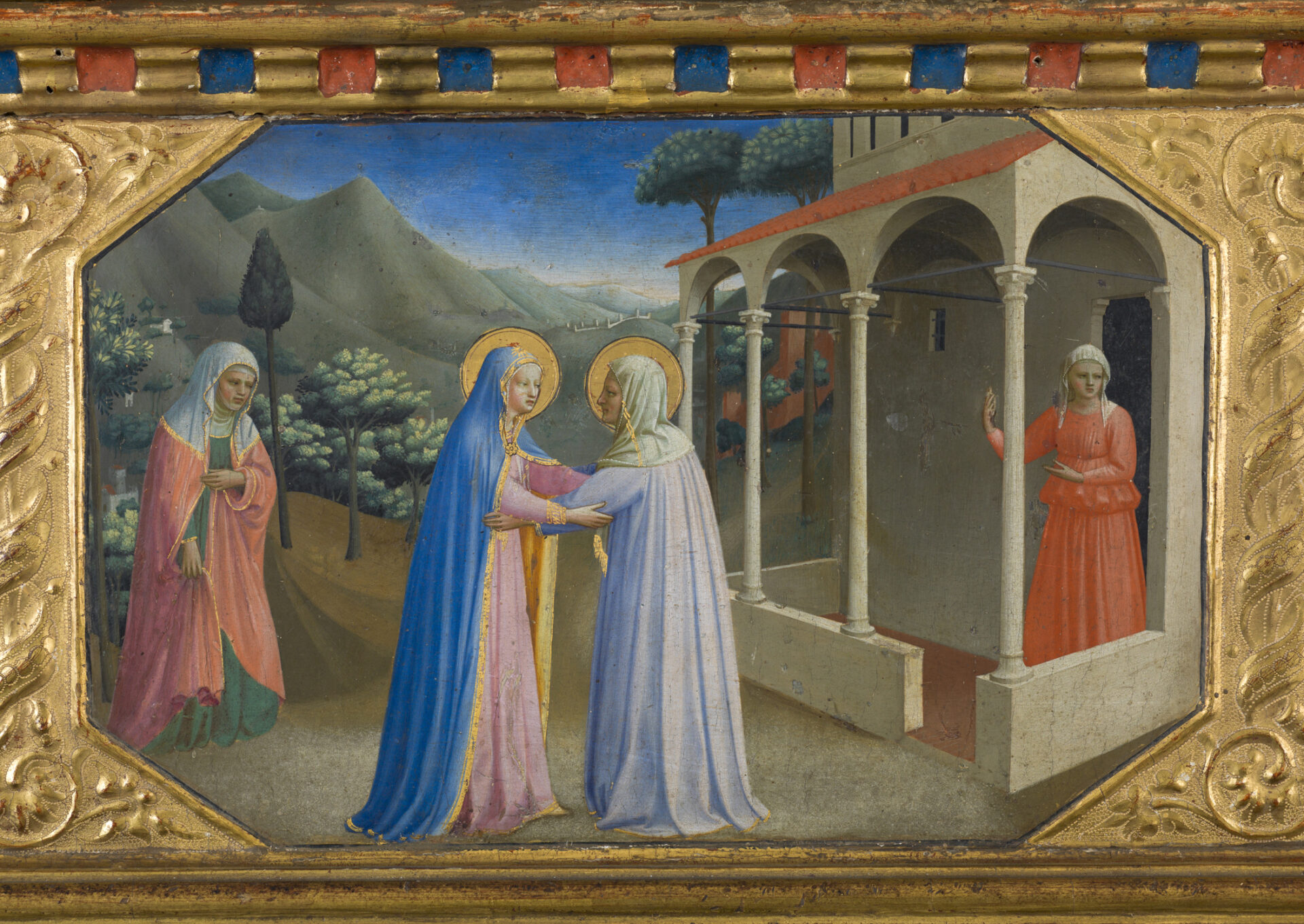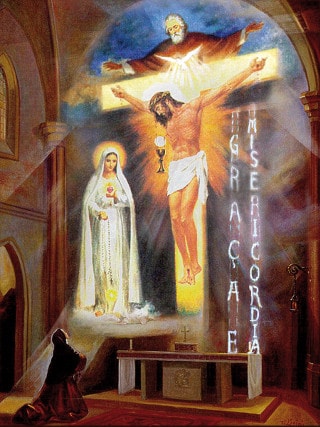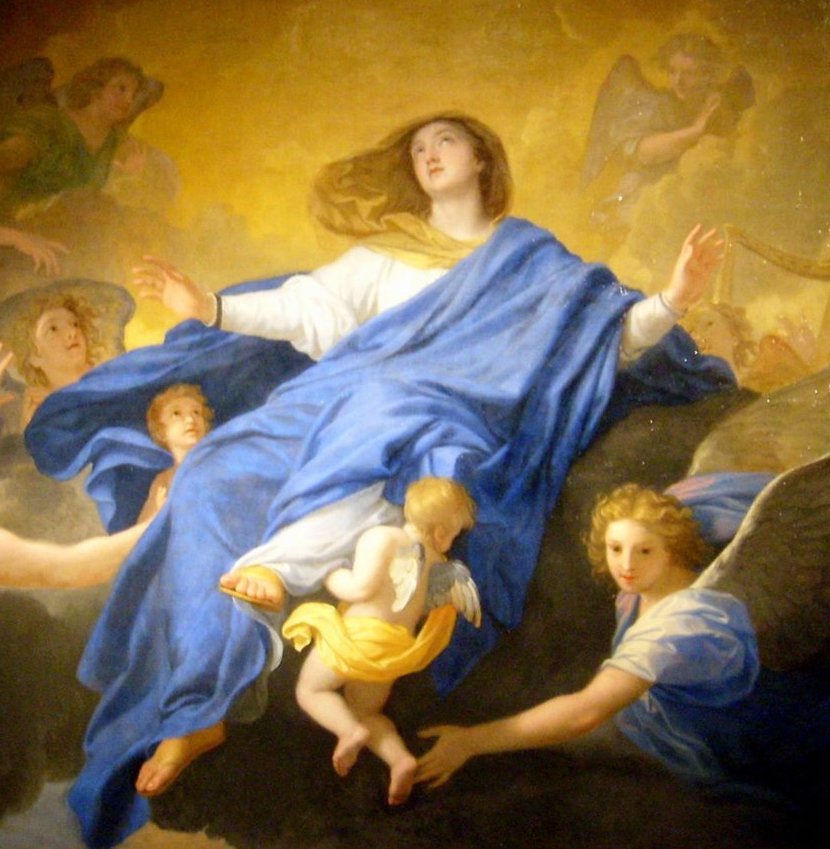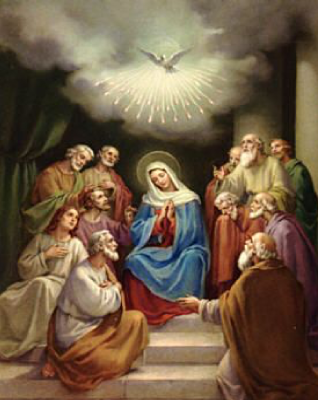The solemnity of “Saint Mary, Mother of God” is celebrated at the beginning of this year, and it’s an opportunity to meditate on the mystery of the Visitation. Indeed, after the Annunciation, the first action of the Mother of God was to set off immediately to see her cousin Elizabeth. These two mysteries are intimately linked, and the Ave Maria associates the two greetings: that of the Angel Gabriel at the Annunciation , “Hail Mary, full of grace, the Lord is with thee”, and that of Saint Elizabeth at the Visitation.
“Blessed art thou among women, and blessed is the fruit of thy womb Jesus.”
But why did Our Lady go so quickly to see Saint Elizabeth and her family? The answer can be summed up in a few words: inspired by the Holy Spirit, she wanted to help her Son begin his work of redemption right away. And since Jesus was still physically in his Mother’s womb, it was she who took him to his first family, that of his cousin. This Visitation, carried out jointly by Christ and the Blessed Virgin, is thus the first act of the world’s redemption. Indeed, at the Annunciation, not a single soul was saved. As Our Lady was conceived without original sin, Christ’s coming into her did not change the purity of her soul, which is the only one in need of “saving”.

It wasn’t until the Visitation that the first souls were delivered from original sin, in particular that of Saint John the Baptist, the illustrious precursor. That’s why the child “leaped” in Saint Elizabeth’s womb. And this beginning of Our Lord’s redemption of the human race is only made possible by Our Lady’s action. The Visitation is therefore a double celebration: on the one hand, it’s the triumph of Jesus Christ, who delivers the first men in history from original sin; and on the other, it’s the manifestation of Mary, Mediatrix of all graces, for this first work of redemption could only have come about thanks to her.
Let’s look at the second aspect of this mystery, and consider Mary’s immense charity: “The The Blessed Virgin, having learned from the archangel Gabriel that her cousin Elizabeth was six months pregnant, inwardly enlightened by the Holy Spirit, knew that the Incarnate Word, who had become her Son, wanted to begin manifesting the riches of his mercy to the world, by granting his first graces to the whole family. Immediately, leaving the restful contemplation to which she was constantly devoted, and abandoning her beloved solitude, she set off for Elizabeth’s house. As charity endures all things and suffers no delay,” says St. Ambrose on this Gospel (Lk. I, 35), “without worrying about the fatigue of the journey, the weak and delicate Virgin promptly set off. (…) The Blessed Virgin’s visit was not like those of the worldly, which are usually reduced to ceremonies and false demonstrations: Mary’s visit brought a treasure of graces to this house. Indeed, at her entrance and first greeting, Elizabeth was filled with the Holy Spirit, and Saint John the Baptist was washed of the original stain, and sanctified; that’s why he gave a sign of joy, leaping in his mother’s womb, wanting by this to reveal the grace he had received through the Blessed Virgin, as Elizabeth declared. Now, if these first fruits of the Redemption all passed through Mary, (…) it is therefore with good reason that the divine Mother is called the treasure, the treasurer and the dispenser of heavenly graces.”
Saint Alphonsus is not the only one to have announced this primordial role of the Blessed Virgin. Numerous saints have also written about it, and Saint Bernardin points out that “the Blessed Virgin, from the moment she became the Mother of the Redeemer, acquired a kind of jurisdiction over all graces.” And after so many saints, it will be the Blessed Virgin herself who will come to show us that she is the mediatrix of all graces , during the apparitions on rue du Bac in 1830 . One detail of the Visitation is interesting to consider. The distance from Nazareth to Elisabeth’s house was thirty-three leagues, as Saint Alphonsus tells us. These thirty-three leagues seem to clearly designate the thirty-three years of Elizabeth’s life.
Jesus on earth, and symbolize the fact that the Blessed Virgin will assist her Divine Son from his Incarnation to his Ascension in his work of redemption.
So we can ask ourselves a question: why did God want to pass through Mary to dispense his graces? This is one of the mysteries of the Redemption. But we can humbly try to approach it. Let’s take the example of a bridge between God and us. God is on one shore, and we are on the other, separated from Him. Indeed, God’s shore (Heaven) is by nature inaccessible to us, for God is infinite and perfect, and we are mere imperfect creatures tainted by sin. So, in his mercy, God creates a first ark for us: his Son, who, while being God, comes closer to our nature by becoming true Man. But as Christ is God, he is by nature still far from us, and a second arch of the bridge will be needed: the Blessed Virgin who, being purely human in nature, is therefore fully accessible to us and even closer.
So all we have to do is take Mary’s ark within our reach, which leads us to the second ark, Christ, who enables us to reach God the Father. The Visitation is a demonstration of this: the Blessed Virgin comes to meet the family of Saint Elizabeth. A purely human encounter. But through this action, she gives them access to Christ. And Christ, by delivering them from original sin, gives them access to the Father. This is why, in the Litany, the Blessed Virgin is called the Ark of the Covenant.
Now consider how powerful Mary is in bringing us to God. Saint Alphonsus de Liguori explains it wonderfully: “Mary obtains from God all that she asks in favor of her servants. Observe,” says St. Bonaventure on the subject of Mary’s visit to St. Elizabeth, “what great virtue Mary’s words have, since at her voice the grace of the Holy Spirit was conferred on Elizabeth and on John, her son, as the Evangelist reports (Luke I). Theophilus of Alexandria says that Jesus likes Mary to pray to him for us, because then all the graces he grants through her intercession, he grants less to us than to his Mother. Note these words through his intercession, for, according to Saint Germain, Jesus can refuse nothing that Mary asks of him, wanting in this to obey her as his true Mother; from which the saint concludes that the prayers of this Mother have a certain authority over Jesus Christ, so that she obtains the forgiveness of the greatest sinners who recommend themselves to her. According to a famous thought of Saint Anselm, sometimes we obtain graces more quickly by having recourse to Mary, than by addressing ourselves to our Saviour Jesus himself. This shows us the essential role of Mary, the keystone of the bridge that leads to Jesus.
And it was in this Chapel of the Miraculous Medal, in 1830, that the power of the Blessed Virgin manifested itself. She came here to visit us, as she had done 2025 years earlier to the family of Saint Elizabeth, to tell us that she was the Mediatrix of all graces. In other words, everything passes through Her, for She is both the Mother of God and the Mother of Men. This is the powerful Ark of the Covenant, the title of Our Lady’s Litany.
Our Lady’s power is both spiritual and temporal. And to mark this, she has asked us to wear two very special signs. At her apparition on rue du Bac, she asked us to wear the Miraculous Medal , which is so effective in protecting us on the material plane. Then, at Fatima, she asked us all to wear the Scapular of Mount Carmel , in order to obtain her special spiritual help in reaching Heaven.
So in 2025, if we haven’t already, let ‘s all obediently wear these two powerful signs of Mary , showing that we humbly place ourselves under Her protection as Her children. Let us ask her to protect us in these difficult times, and may she lead us to heaven with her Son for all eternity. And for this, there’s nothing like imploring her by reciting the rosary every day, as she so insistently requested at Fatima: “Holy Mary, Mother of God, pray for us poor sinners now and at the hour of our death.”
Alliance 1st Saturdays of Fatima





